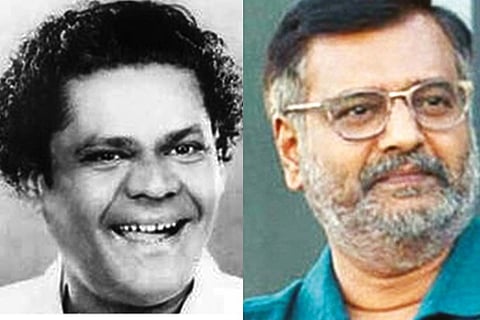Social justice and Tamil cinema inseparable twins
Chennai
From the good old days of NS Krishnan and M Karunanidhi to comedian Vivek and director Pa Ranjith’s contemporary cinema which questions the remnants of absolute caste domination, the genre has transcended the boundaries of art and courageously spoken politics and social science with envying authority.
While NSK exposed the evils of varna system using Tirukkural to debunk it in his movies, Karunanidhi overlooked euphemisms and took casteism by the scruff of the neck. “The whole world is inside this tiny book. Mirror shows the dirt on the face, Tirukkural is a mirror which shows the dirt in one’s mind. A copy of it should be available in every household,” said NSK in the movie Panam (money - 1952).
Karunanidhi took a more direct approach in his magnum opus Parasakthi, which was and is still considered a watershed moment in Tamil cinema. “Ambal entha kaalathiley pesinal. Athu pesaathu. Athu kal. (When did ambal (God) speak? It will not. It’s a stone)” were the immortal lines from Sivaji starrer (debut) Parasakthi in 1952, which marked a seismic shift from spirituality to atheism.
Celebrated for its linguistic splendour, the court scene dialogue criticizing the muck in early 20th century Tamil society and celebrating proletariats became a benchmark for actors later. The atheist and rationalist principles immortalised by Karunanidhi through Parasakthi was second, if not matched, two years later when MR Radha translated his super hit drama Ratha Kanneer into movie, which again sent shockwaves in the tinsel world for its daring dissemination of the rationalist and anti-caste principles of the Dravidian movement directly on screen.
Though the works of Kannadasan had a political undertone, none incited a cultural revolution, as did the prodigies of Dravidian movement through cinema. Chandrababu, MGR and SS Rajendran were some of the willing participants in improvising cinema for a sociocultural transformation in 50s, 60s.
CN Annadurai, another former CM, is another politician-playwright without whom a study of social justice in Tamil cinema and drama would be incomplete.
To an art form only used to treating mythological stories, it was Anna who introduced Velaikaari (servant maid), Or Iravu (one night) and Thookumedai (at the gallows) to the ordinary Tamil audience. Anna-penned Sorgavasal (1954), a critique of godmen, was another noteworthy movie that whipped up a frenzy among the conservatives then.
Even a stereotype director like Ramanarayanan has had his share of socio-political propaganda by preaching the virtues of socialism in Vijayakanth starrer “Sivappu Malli” (1981), another politically sensitive movie which sufficiently drew the attention of the censor board.
Amaithi Padai fame Manivannan is another moviemaker who belongs to the rationalist school of thought. A left leaning Manivannan, who directed Karunanidhi penned Paalaivana Rojakkal, did not mind disclosing his liking for Periyar’s self-respect and anti-caste ideology in many movie dialogues. The sarcastic exchange between Manivannan and Sathyaraj in Amaithipadai is a strong case in point. When a subservient Manivannan asks who invented caste, Sathyaraj, playing a MLA, says, “Mandaram otharavanga kandu puduchanga. Manthirimaar kettiya puduchutaanga (Chanting priests invented it, ministers held on to it),” tersely tracing the origin and sustenance of caste.
The likes of K Balachander, who improvised several works of writer Jayakanthan and K Bharathiraja, who debunked caste in his Vetham Puthithu also deserve special mention in Kollywood’s treatment of social justice and caste. However, the dawn of a new millennium and early 21st century saw a decline in Tamil cinema’s treatment of the long championed principles of social justice with only comedians like Goundamani and Vivek vilifying regressive ideas like caste on screen, to such an extent that it earned Vivek the moniker Chinna Kalaivanar (NSK).
After a period of lull, pan out to the second decade of 21st century, in came the new breed of progressive thinkers like director Vetrimaran, Pa Ranjith and Mari Selvaraj who introduced Tamil society to a new world of ideological cinema. “If we have money or land, they will snatch it from us. But they can never take away education from us. So, learn,” thundered Vetrimaran through Dhanush in blockbuster movie Asuran, a celebration of Dalit resistance that created ripples across the state. If Maari Selvaraj’s Pariyerum Perumal emphasized educational upliftment to defy caste, Sarpatta Parambarai was the most recent commentary of Dalits fighting back against caste oppression served on screen by Pa Ranjith.
Sahitya Akademi winning writer Imayam traces the link between social justice and cinema to Parasakthi and says; “DMK was a propaganda movement. Debates, newspapers, drama and cinema were used as campaign tools by the writers of Dravidian movement. Art was not important for them. They did not use the medium for fame or money. They did it to popularize their ideology. At a time when people were ostracized and asked not to learn, these writers brought laymen on stage and asked people to learn. Their work was a critique of their society. They successfully broke the caste hegemony and captured power.”
Complaining that the treatment of social justice has become a mere trend that could not be seen in Rajinikanth or Kamal movies, the Sahitya Akademi winner said, “Women have been largely reduced to mere glam dolls and item song dancers in contemporary cinema, unlike the Dravidian cinema which was an extension of a knowledge movement. You cannot alienate Dravidian movement from TN politics or cinema or any field. It will remain intertwined forever.”
Visit news.dtnext.in to explore our interactive epaper!
Download the DT Next app for more exciting features!
Click here for iOS
Click here for Android

